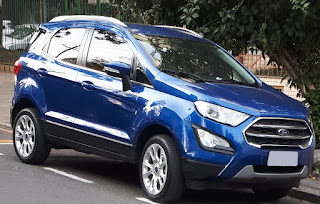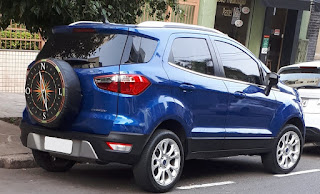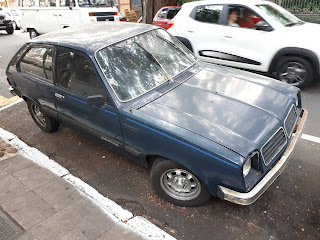Initially targetting to poor Latin American markets, the Ford EcoSport became a global model with its second generation, which after a facelift started a switch from the 4-cylinder layout to 3-cylinder on the majority of its 2-wheel drive versions, even though 4-wheel drive ones retain the 2.0L Duratec Direct 4-cyl engine. Among the newer engines, there are a turbocharged Ecoboost derivative of the 1.0L Fox and the naturally-aspirated 1.5L Dragon, this one also available as a flexfuel in Brazil. Quite surprisingly, with Diesel engines struggling to remain competitive along the challenges regarding the ever-tightening emission regulations, the 3-cylinder layout is seemingly overlooked by Ford as a viable measure to decrease the cost impact for buyers who look at a turbodiesel engine option as a matter of necessity instead of a luxury.
In a moment when Ford was one of the few automakers with an operation in India that did not stepped out of the Diesel field right after the Bharat Stage-VI norms became effective in April, despite the local market keeping only the Dragon for those who prefer a gasoline-powered engine being supposed to set the price gap more unfavirable to Diesel as the spark-ignited engine with port-injection requires fewer aftertreatment devices which have been blamed for most of the recent price increases on turbodiesels throughout all the markets where they are or at least used to be relevant for light-duty cars and SUVs. A simpler and presumably more affordable engine, even though it could turn out to not attract so much to a broader buying pattern as in the early days of the common-rail turbodiesels when the performance got closer to that of a naturally-aspirated gasser within a similar displacement class, seems likely to offset a cost disadvantage induced by the presence of so many exhaust filters and even one more injector which is quite expensive in an electronically-controlled engine compared to their old-school mechanically-governed counterparts. Considering the recent announcement of a joint-venture between Ford and Mahindra, which manufactures its own engines for many different vehicle classes including a newer 3-cylinder turbodiesel within the same 1.5L class of the current EcoBlue which is now the only 4-cyl engine available for the EcoSport in India, relying on an outsourcing at least for the local Indian market and regional exports would not be so pointless at all.
It's also worth notice the stricter deadline for motor vehicles to remain eligible for a registration in New Delhi and other Indian metropolitan areas, which is also biased toward the engine type with Diesel in a less favorable condition calling for their registration in these regions to expire in 10 years, while their gasoline-powered counterparts can go for 15 years. Even though the newer and stricter emission rules are putting both engine types on par when it comes to limits for the same parameters, this situation is uncertain to become a sign of change in order to grant a similar treatment for all vehicles regardless of fuel type, thus justifying even more the market opportunities for a simpler engine focusing on the core advantages of Diesels when it comes to reliability and fuel savings. So, while gassers already overcame the misconceptions about fewer cylinders rendering them somewhat "inferior", it's time to look at their Diesel counterparts in a similar way.
Sunday, September 27, 2020
Thursday, September 17, 2020
Could it have avoided GM too much trouble with China if it insisted on rear-wheel drive for small cars?
GM took a quite conservative approach in the '70s and '80s with the Chevette in the American domestic market, and throughout Latin America where in some markets it lasted until mid-'90s. Sure it seems too crude for modern standards, while its persistence in the rear-wheel drive layout when many contenders at the time had already switched to a front-wheel drive and transverse engine configuration might sound like an excessively outdated approach. On the other hand, looking at some present-day Chevrolet small cars and models which had been released in a meantime after the Chevette had been phased out, there is no way to disconsider how rear-wheel drive could have avoided GM a lot of trouble not only in some of its former traditional markets but also at its Chinese joint-venture operation where it gives too much for its local partner for a somewhat unfair return.
Even though it may seem foolish at first to consider the possibility of refraining from fitting a modern car such as the second-generation Chevrolet Onix with any layout other than front-wheel drive, there is at least one main reason why it would've been sensible to consider the rear-wheel drive at least for the Chinese market where the model was premiered worldwide. Unlike the other countries where the Onix is made, namely Brazil and Mexico, the Chinese operation is not fully owned by GM and is tied to the requirement of technology transfer for the state-owned SAIC Motor which is its local partner. Chinese communist dictatorship has a total disregard not only for human rights, but also to intellectual property of the foreign companies lured by its low labor cost akin to the old "coolie trade" system which served the role of a replacement for black slavery, and so its state-owned enterprises resort to the technologies transfered by traditional automakers in order to take over their presence on some overseas markets such as Latin America and Africa.
Considering the Chevrolet Onix still retain a center tunnel, which would clear the way for a propshaft in a hypothetical rear-wheel drive variant, that approach would eventually make sense somewhere else due to some advantages of this setup which are unfortunately overlooked nowadays, but it might seem even more stupid how GM ceded too much and received too little in exchange for its technology transfer. It's worth to consider the way SAIC's subsidiary Wuling benefitted from Chevrolet's traditional nameplate as a way to reach export markets with its microvans such as the Rongguang rebadged Chevrolet N300 in some Latin American markets where it often competed for market-share with products made by some fully-owned GM regional subsidiaries. Factors such as local economics of scale could have been more favorable to an adaptation of the rear-wheel drive layout into a modern front-wheel drive GM platform, allowing some parts commonality which would be able to save GM the expense of giving away modern powertrain technologies to the Chinese dictatorship for free and turn it into a fierce contender in many overseas markets where it now struggles to retain a foothold.
It's worth to notice the rear-wheel drive layout of most Wuling microvans, itself copied from Mitsubishi projects, is actually advantageous on the crowded Chinese large cities as it allows a tighter turn radius due to the absence of front-wheel drive half-shafts imposing a narrower limit to the maximum steering angles. Another aspect which may be relevant is the perception among the average Chinese customers that a 4-cylinder engine, even the much basic ones offered in the Wuling Rongguang, as if they remain inherently better than any 3-cylinder counterpart such as the 1.0L turbocharged which is currently fitted to the Chevrolet Onix. Even though GM was making some huge profit in China that seemed convenient to overlook some deficitary operations in traditional overseas markets such as Australia and Europe, or even India which now hosts only an export operation catering to some Latin American countries while SAIC took over an India-focused production and retail for its own MG brand, another critical matter in recent times has been a slower recovery of sales figures in China for the American joint-ventures than it has been for their Japanese and German counterparts and independent local automakers.
Even though the second-generation Chevrolet Onix was jointly developed by GM and SAIC, it actually had a large Chinese input during the development of its GEM (Global Emerging Markets) platform, so it could have eventually offered a good opportunity to look more seriously into rear-wheel drive instead of being so strict with the front-wheel drive layout. On the other hand, with front-wheel drive being so unnegotiable for other markets such as Brazil where a hatchback bodystyle had to be locally developed to ensure the Onix would remain a best-seller, the investment on modern platforms to be designed from scratch could seem harder to justify at first due to the disregard of an overwhelming majority of new car buyers for aspects such as safety features, but it's worth notice tough riding conditions in Brazil provide the chance to test the vehicles under a considerable amount of circumstances allowing to gather enough data to ensure reliability and balance it with an ease of maintenance much valuable not only among the local customers but also in regional export markets.
Subscribe to:
Comments (Atom)













